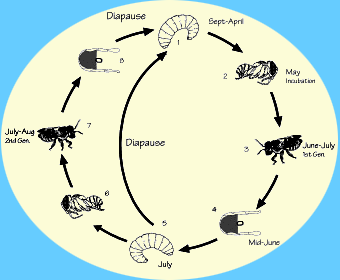



(1) Mature Larva - The Leafcutting
Bee overwinters as a mature larva. Storage at 50�F prevents development.
(2) Pupa - When temperatures increase in the spring, the larvae begin
to develop and pupate. Development is fastest at 86�F. The incubation
period lasts from 3 to 4 weeks.
(3) Adults, first generation - The pupae give rise to adults which must
chew their way out of their cocoons. Males emerge first after about 18
to 20 days of incubation. Females emerge from 21 to 24 days after incubation.
 (4) Egg - Females mate immediately after emerging. They then select a
hole and begin to provision cells. Eggs are present a few days after females
begin flying. A female can construct one to two cells per day, depending
on conditions. Each cell is made up of a leaf-lined cup packed partially
with pollen. The bee deposits a small droplet of nectar on the surface
of the pollen and lays the egg in the nectar.
(4) Egg - Females mate immediately after emerging. They then select a
hole and begin to provision cells. Eggs are present a few days after females
begin flying. A female can construct one to two cells per day, depending
on conditions. Each cell is made up of a leaf-lined cup packed partially
with pollen. The bee deposits a small droplet of nectar on the surface
of the pollen and lays the egg in the nectar.
(5) Mature Larva - Larvae reach maturity in about 3 weeks, depending on
temperature. The larva will then either proceed into diapause (a hibernation-like
state in which they overwinter) or they will continue developing to produce
a second generation.
(6) Pupa - When pupae are found in the nests, they will inevitably hatch
as second generation adults. In warmer climates such as California, 40
to 80% of the larvae may develop into second generation.
(7) Adult - These second generation adults appear about a month after
eggs are laid. These adults will readily use the nest holes from which
they emerged.
(8) Egg - Eggs are laid by second generation adults within a few days
of nesting. These eggs will hatch and the larva will mature and go into
diapause. A small percentage will continue to develop and create a third
generation. These adults emerge in late August and September, too late
for alfalfa pollination. The diapausing larvae can then be held in cold
storage until the following spring when they can be incubated.